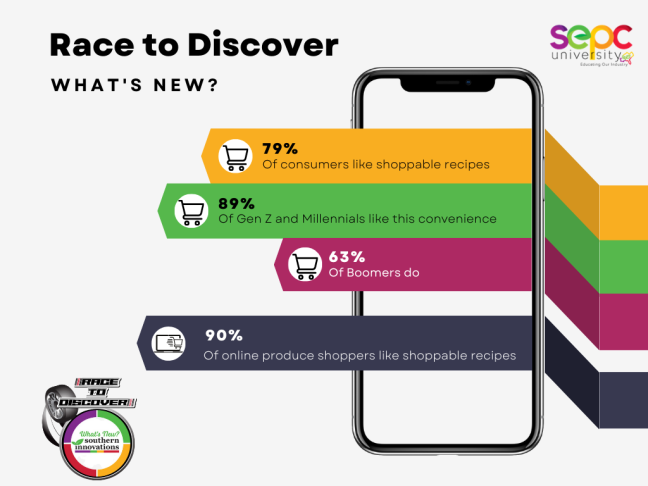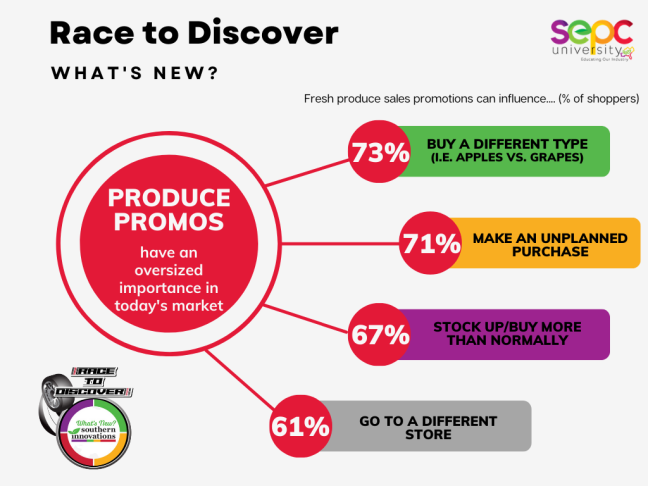The Southeast Produce Council (SEPC) released its annual “What’s New? 2023″ consumer research in a sold-out educational session at Southern Innovations, held Sept. 14-16 at the Charlotte Convention Center in Charlotte, North Carolina.
Pioneering organizations will provide additional innovation-focused presentations in the “What’s New?” theater on the exhibit floor.
“Only one-third of consumers tend to consume fresh produce every day,” said David Sherrod, president and CEO.
“Additionally, 51 percent readily admit that they find it hard to reach the recommended daily amount of fruit and vegetables or are unsure what that amount even is. That means current consumption patterns leave ample room for growth for fresh, while recognizing the tough economic marketplace. We studied the big consumer-driven sales trends to understand how innovations within each area may reveal pockets of growth for the remainder of the year, going into 2024.”
The top findings for each of the trends in the research are as follows.
Value
“Consumers are engaged in a constant balancing act, switching dollars between foodservice and retail as well as between produce types, channels and amounts purchased,” Sherrod said.
“The ultimate value equation is far more than the lowest price alone. No less than 86 percent recognize that they will splurge a little for the right reasons, topped by doing something nice for themselves or friends/family. Health, sustainability, convenience and special occasions/holidays are other important reasons to spend a little more.”

The SEPC’s research found that:
- Restaurant visits remain more planned and are viewed as a treat. When eating out at restaurants, the focus is on the main entrée or choosing a restaurant that fits the budget to start with. Fifty-four percent of consumers occasionally or frequently add store-bought produce to restaurant takeout or delivery.
- Fresh produce promotions are powerful in the current climate, able to steer consumers to a different type of produce (73 percent), make an unplanned purchase (71 percent) or visit a different store (61 percent).
- Sixty-two percent of consumers believe personalized sales promotions to be a good or great idea, while only 31 percent are enthusiastic about dynamic pricing (31 percent) when buying fresh fruit and/or vegetables.
- Consumers are more hesitant to buy a fruit or vegetable they have never had before, recognizing routine is a big purchasing factor in fresh produce (47 percent) along with not wanting to risk buyer’s remorse (38 percent).
Health and well-being
“In the eye of the consumer, fresh produce has always been synonymous with health and nutrition. That said, the definition of health has evolved to reflect both physical health/nutritious choices and emotional well-being or happiness,” Sherrod said.
The SEPC’s “What’s New” research discovered that:
- Two-thirds of consumers place some or a lot of focus on making healthy food and beverage choices in general, and 77 percent agree that physical health and emotional well-being are interwoven.
- Seventy-six percent of consumers buy produce items specifically for their known health benefits, with Vitamin C as the big top-of-mind nutrient when consumers think about fresh fruit or vegetables.
- At the same time, 83 percent of consumers believe that veggie pasta, meat or supplements can help people reach their recommended daily amount of fruit and vegetables.
- Sixty-two percent of consumers are interested in earning produce perks by sharing their physical activity, nutrition, lifestyle and sleep habits through apps.

Planet and people
“Consumers connect the dots between health, planet and people,” Sherrod said.
“While economic pressure has created many competing choices, there remains willingness to spend a little more for items that are grown more sustainably, reduce package or food waste or highlight solutions for people in the supply chain or community.”
- Eighty-three percent of consumers believe grocery stores and restaurants should aim to reduce single-use plastic.
- Half of consumers believe it is very important for grocery stores and restaurants to widen access to fresh produce to underserved communities and company employees.
- Eighty-two percent are interested in knowing more about the who, where and how of store-bought produce with a key communication role for the package label and websites. “The survey identified an opportunity to share and educate but also a need to keep it simple, using consumer-tested language to avoid misconceptions,” Sherrod said. “For instance, we tested regenerative agriculture, and 38 percent of consumers incorrectly defined it as monocrops or growing GMO crops — very much not the message these growers are trying to convey.”
- The survey also found theoretical consumer interest in loosening produce specs to display a wider variety of sizes and the use of recyclable bins (RPCs) with an eye on reducing food and package waste.
- One in five consumers struggle with fresh produce waste at home.
Convenience
“Life is hectic and expensive at the same time that many Americans try to find a better work/life balance. This has led to inconsistent shopping behaviors that reflect cooking from scratch to save and ultra-convenience all at once,” Sherrod said. “As such, retail and restaurant visits and meals are about time-well-saved as much as about time-well-spent.”
The SEPC shared that the research found:
- Consumers are somewhat de-emphasizing convenience in their purchase decision, while highlighting health, taste and value. Interest in value-added solutions is down a little compared to last year. This is also reflected in Circana value-added sales in which pounds dropped 5 percent year-on-year. However, value-added remains a big opportunity, at $11 billion in annual sales, according to Circana.
- Consumers say they would purchase more value-added with a smaller price differential and better shelf life.
- Consumers are also finding convenience in smoothies, squeeze pouches, shots and supplements, especially younger generations — demonstrating that the competition is far wider than frozen and canned alone.

Technology
“Technology has made great inroads in farming, retailing and foodservice. But for consumers, technology often reflects a great paradox,” Sherrod shared.
“Consumers welcome technology in many parts of their lives yet have many questions about others, such as innovations that improve taste, nutrition or sustainability aspects of fresh fruit and vegetables.”
- Routine meals are making a comeback, but digital remains a big source of meal inspiration and tips, led by recipe websites (39 percent of consumers), YouTube (28 percent), Facebook (26 percent) and other big social media platforms.
- Already, 5 percent of consumers use artificial intelligence such as ChatGPT for meal planning. Consumers see AI as a potential tool for recipe ideas, nutrition information and cooking appliance instructions.
- Seventy percent of consumers are interested in shoppable recipes, but the number of households buying online has plateaued.
- Virtual worlds sustain large economies, and 24 percent believe brand, retail and restaurant experiences in virtual worlds have an impact on their real-life shopping habits.
- Consumers see many good uses for QR codes, led by nutrition information, recipes, storage tips, brand and sourcing information, but usage remains relatively low, with 50 percent using QR codes rarely or never.
The SEPC’s “What’s New?” online research was conducted among 1,887 consumers and presented by 210 Analytics. The study was fielded in August, and a complete copy of the findings can be requested by contacting Anna Burch at SEPC.
Read more produce news from The Shelby Report.

